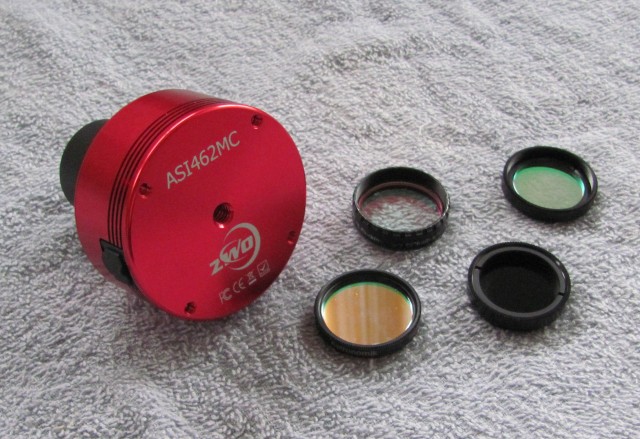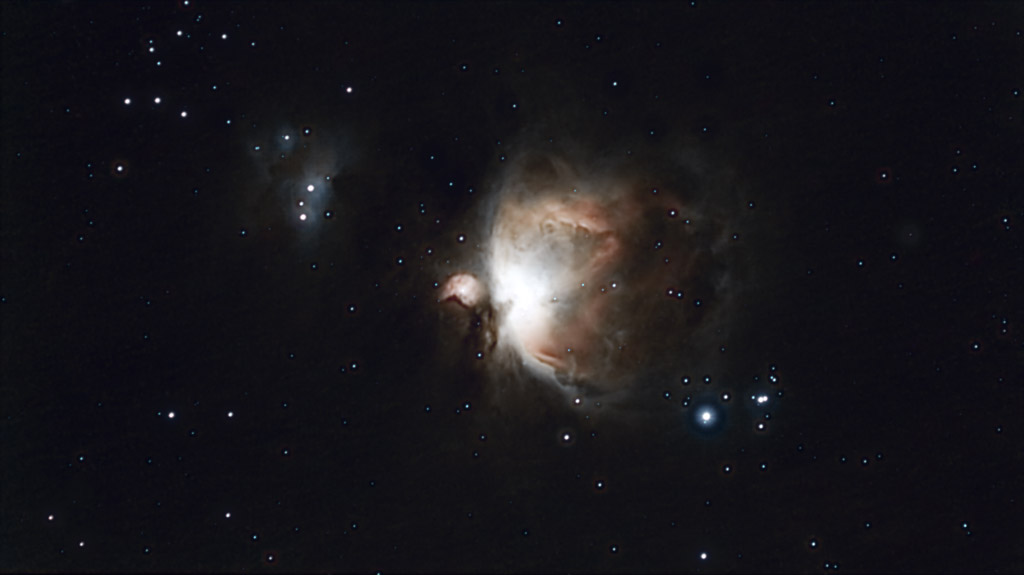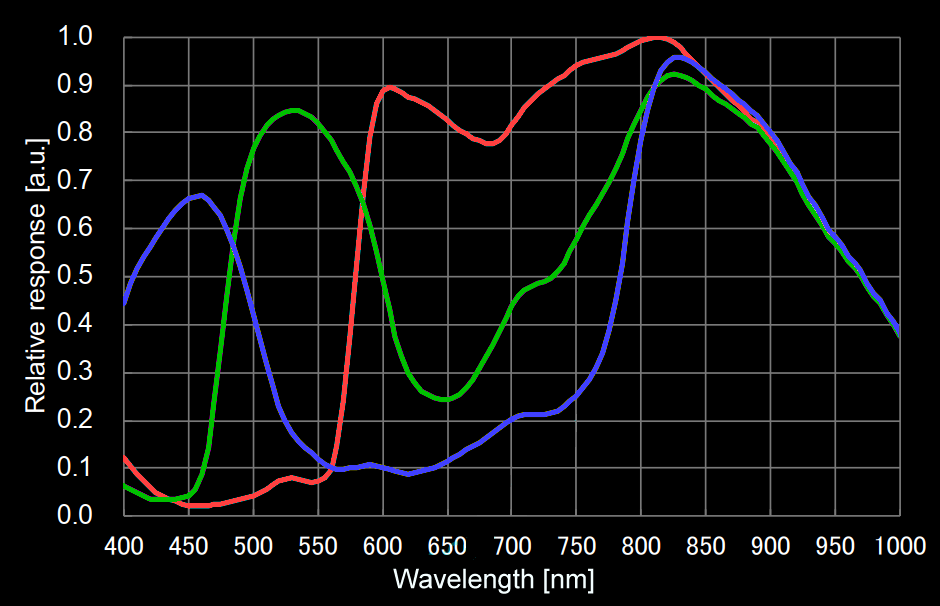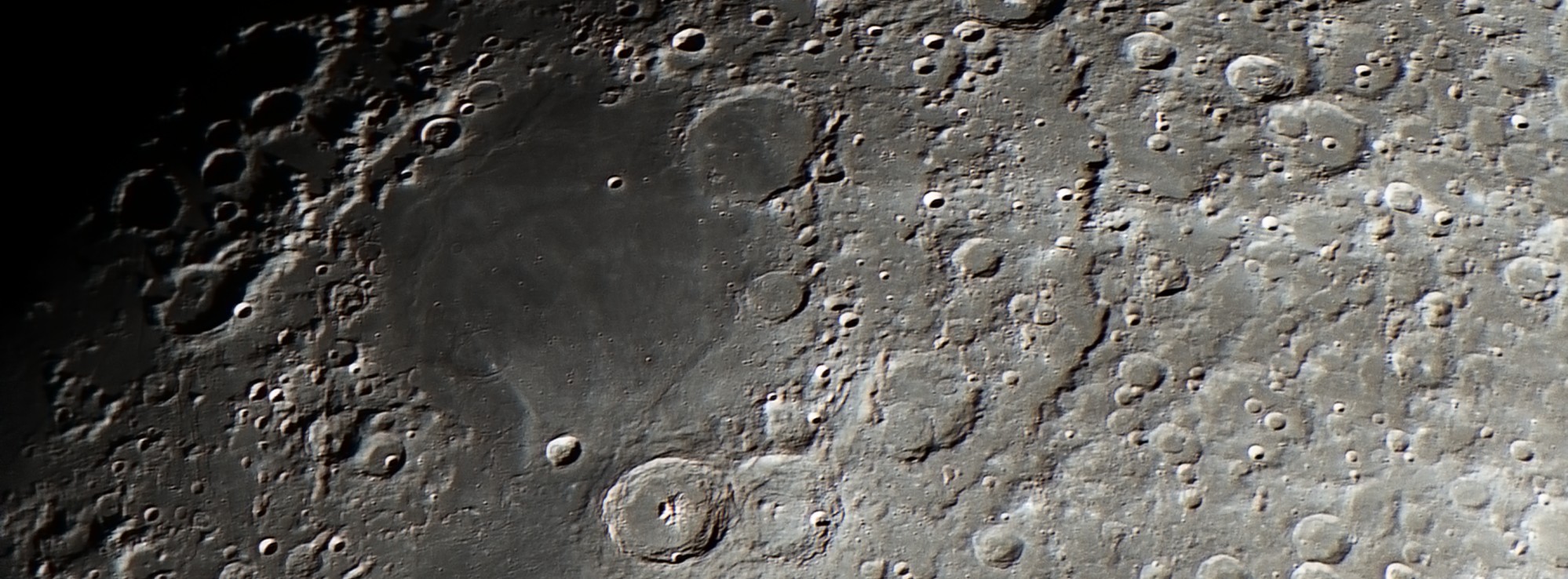Equipment Review (Preliminary)
ZWO ASI462MC
Purchase price: JPY 39,100
Dealer: KYOEI-TOKYO
Conclusion: Top Shelf in Infrared
Please appreciate that this review reflects personal impressions and views.

ZWO ASI462MC color CMOS camera with bundled 1.25" adapter and optional filters.

A quick experiment with M42. ASI462MC with Samyang 135mm at f4 through a quad band filter. A live stack of 231 frames, exposure 15 seconds at gain 170. The shadow-like halos are artefacts from processing with a starless layer. Background noise was virtually absent.
The latest planetary camera developed by ZW Optical resembles the company's ASI290MC (discontinued) color camera in most respects but sports two significant improvements, unparalleled high sensitivity in near infrared and lower readout noise. The high advantage of infrared sacrifices sensitivity in visual color as compared with the ASI290MC, but not dramatically. At about 800nm wavelength, the peak sensitivity in infrared is as high or higher than in RGB. The new camera's infrared efficiency nearly doubles that of the ASI290MC from 800 to 1000nm wavelengths. The camera's quantum efficiency, QE, is estimated to reach 90% at 850nm, but should be taken with a grain of salt.
Note: Some internet sources suggest(ed) that a Bayer matrix (color split filter) "becomes transparent" at near infrared. This is not confirmed by ZWO. Recording infrared in 8-bit mono results in monochrome images, indeed, but not at the same resolution that of a monochrome camera (though pretty close), such as the size-comparable ASI290MM.
With its HCG mode readout noise at high gain is considerably reduced without sacrificing much dynamic range versus lower gain. HCG mode is automatically engaged when gain is set to 80 and above. The ZWO ASI462MC CMOS camera contains a sensitive color sensor with 12-bit ADC capable of recording in 8-bit or 16-bit raw or in 8-bit grayscale. Its extremely well crafted body incorporates a B-type USB 3.0 computer port (control port and power source) as well as an ST4 autoguiding port which connects to a compatible equatorial mount via a straight RJ11 6P6C cable. The ASI462MC sports Sony's back-illuminated IMX462, a 1/2.8" sensor (5.6mm x 3.2mm, 6.46mm diagonal) with 1936 x 1096 pixels (HD aspect), 2.9μm square. An anti-reflection filter serves as optical window to protect the sensor from dust, humidity and scratches. The back focus is 12.5mm. The camera body weighs 110 grams and bundles a simple 2.1mm CCTV lens providing a 150° sky view, which is a nice gesture of ZWO since the camera's sensitivity is well suited for, say, wide field meteor monitoring.
In both visual and infrared, when writing 8-bit image files, the ASI462MC suffices with short exposures and frame rates as fast as 138fps at maximum image size. Also remarkable is the camera's low noise performance.
When using 2x binning with the capture software the camera treats 4 pixels as if one, collecting four times more light sufficing with shorter exposures, however, at less detail and halved image size. When imaging small planets, the camera can crop the area it processes thus significantly increase the video frame rate (ROI function).An unparalled color and near infrared imager. No doubt, the experts at ZWO know exactly what they are doing.
When using the bundled CCTV lens, please adjust focus slowly and be sure to not focus beyond infinity because the lens, when screwed in too deep, can scratch the optical window.
Filters
The ASI462MC contains an anti-reflection (AR) window as a dust shield in front of the sensor which passes both visible and infrared. It is basically like a modded DSLR. Although the ASI462MC is not specified for deepsky imaging it is sensitive enough in both color and infrared for experiments with bright deepsky objects while it can be used with narrowband filters such as Quad Band or Hα. The primary application however is for lunar and planetary imaging, largely because of the small chip and resulting fast frame rates. Planetary imaging can benefit from an optional CH4 methane filter, in particular for cloud planets.
The full spectrum luminance without external optional filters is remarkably high, however, for imaging the moon and planet in color an IR-cut filter is indispensable since the infrared portion washes out colors and is not focused in the same plane (some reflectors actually do focus both correctly). Likewise, in order to make full use of the calming effect of infrared at poor seeing an IR-pass filter is required for infrared imaging. The suitable pass start wavelength depends on the telescope's aperture and seeing condition, usually between 610nm and 850nm while the camera's response drops with increasing wavelength. In most cases a 640nm filter is the best choice whereas a 850nm filter will compromise details and frame rate.
Since the built-in AR window notably starts attenuating light above 650nm wavelength it may be a good idea to remove the window when using an external optional IR-pass filter with high permeability. A permanently externally attached filter can protect the sensor as well (this is a personal view and NOT specified by ZWO).
 Relative response curve (QE) of the ASI462MC.
Relative response curve (QE) of the ASI462MC.
Test Images
Image stacks taken with the ASI462MC on a Celestron C8 with 200mm aperture. Captured with SharpCap and processed 1.5x drizzled with Autostakkert!3 plus curve adjustment and a high-pass filter applied in Photoshop. Note that sharper images can be obtained at higher resolution with better atmospheric seeing.
 Celestron C8, 0.5x reducer, ASI462MC, 4ms, gain 100, 250x, 138fps, IR-Cut, 5x mosaic
| Full Screen
Celestron C8, 0.5x reducer, ASI462MC, 4ms, gain 100, 250x, 138fps, IR-Cut, 5x mosaic
| Full Screen
 Celestron C8, no barlow, ASI462MC, 6ms, gain 80, 600x, 138fps, IR-Cut
| Full Screen
Celestron C8, no barlow, ASI462MC, 6ms, gain 80, 600x, 138fps, IR-Cut
| Full Screen
 Celestron C8, no barlow, ASI462MC, 4ms, gain 150, 400x, 138fps, IR-Cut
| Full Screen
Celestron C8, no barlow, ASI462MC, 4ms, gain 150, 400x, 138fps, IR-Cut
| Full Screen
 Celestron C8, no barlow, ASI462MC, 3ms, gain 150, 400x, 138fps, IR-Cut
| Full Screen
Celestron C8, no barlow, ASI462MC, 3ms, gain 150, 400x, 138fps, IR-Cut
| Full Screen
 Description on image.
| Full Screen
Description on image.
| Full Screen
Many further samples in the gallery...
Pros
- Extremely high near-infrared sensitivity
- Sufficient frame rate at maximum resolution.
- Excellent readout noise performance at high gain
- USB 3.0 control interface
- Includes a 2.1mm CCTV lens
- Light weight, solid construction
- Easy sensor access for cleaning
- Comes with intuitive capture software
- Quarter-inch tripod thread
- Bundles all needed adapters and cables
Cons
- The C-adapter ring can get stuck in the thread (two holes are drilled to help get it loose; use wooden sticks). A minor issue.
Wish List
- Dead pixel detection
- Internal buffer memory

